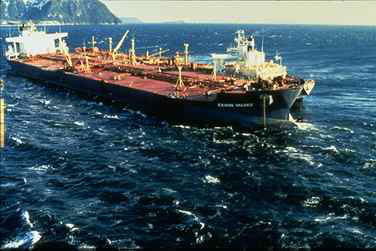10.17.1: Cultural Connections- Oil and Water
- Page ID
- 50864

Oil has been a staple of our every day lives for thousands of years. In ancient times it was used as a fuel source, but more widely as a medicine. In the late 19th century oil was found in the Texas area, and from then on the world would never be the same. Oil was used for cars, planes, fuel, and helped to spur the industrial revolution. With the profitability of oil rising, many oil companies and drilling areas evolved around the world. The production and extraction of oil became one of the most profitable business in the world. However, a major problem with the oil industry was that it was all around the world. In order to get oil to the largest consumers the oil had to be shipped. Some of the largest oil reserves in the world are in the middle east, Alaska, and in the deep ocean. Each of these places has great access to shipping lanes, and therefore have been very profitable. However, a major problem is that along with the shipping lanes comes huge bodies of water, and oil and water definitely don't mix.
In 1989 an Exxon Valdez tanker was taking oil from Alaska to California. It ran aground and spilled 32 million gallons of oil all over the Alaskan coastline. The spill took place in Prince William Sound, which is in Southern Alaska by the Kenai Peninsula. The oil spread to over 1,300 miles of coastline and 11,000 square miles in the ocean. 250,000 animals were killed in the spill, including endangered species like the Bald Eagle. The reason that the oil is so deadly is that it sits on top of the water, because the two are not miscible, or do not mix. The sea life or birds come to the surface and get caked in oil. When covered in oil the birds wings do not work, and gills of fish are covered and they can't breathe. No animal is safe from the oil. The Exxon Valdez spill was extremely destructive, and was the United States' largest oil spill until the 2010 sinking of the oil rig Deepwater Horizon off the coast of Louisiana. The Louisiana oil spill released over 90 million gallons of oil into the ocean. However, these two oil spills are minute compared to some of the biggest in the world. These include the Kuwait oil spill (336 million gallons) and the Ixtoc, Mexico oil well collapse (140 million gallons). All oil spills no matter how big have devastating effects on the environments for many years because of the difficulty of cleaning up oil.
It could be seen that oil would be easy to clean up because it is not miscible with water. It seems easy to simply take off the top layer of oil and that would be it. However, the problem is that there is no great solvent to dissolve the oil. Many different techniques are used to clean up oil. One of these techniques is called using a dispersant. The dispersant takes large clumps of oil and breaks them down to very small particles. Since there is so much water available, and the particles are so small, the oil starts to be dissolved into the water column. The problem though is that with excessive amounts of oil, the water column can become toxic because of the large amounts of oil being dissolved. Another technique is to use skimmers. The skimmers take the oil off the water and get rid of it. The skimmers are prone to clogging though, especially with thick oil. One option that many people ask about is burning the oil. This is done to some extent, but burning oil creates many bad after effects for the atmosphere and people to breathe in. There really is no silver bullet in treating an oil spill, and because of this all of the above are done to clean up an oil spill.
Why Oil and Water don't Mix
In basic chemistry classes everyone learns that in solvent chemistry like dissolves like. In a more in depth sense, polar solutions dissolve polar solutes, and non-polar solvents dissolve non-polar solutes. In the case of oil and water, one is polar (water), and the other is non-polar (oil). Water is polar because of the bonds between oxygen and hydrogen are polar. The electronegativity difference between these two elements is about 1.24, meaning it is very polar. The water molecule is in the bent shape, which is important because the two polar bonds don't cancel each other out. For oil on the other hand, none of the bonds are polar. Oil is made of alkanes, or long carbon chains. Gas fuel for cars is made up of carbon chains between 5-8 carbons long and diesel and jet fuel is made up of carbon chains of 9-16 carbons long. These are the kinds of oil that the Exxon Valdez was carrying, and are components of every oil spill. Alkanes are simply made up of carbons and hydrogens, and the electronegativity difference between these elements is only .35. This means that the bonds are not polar. Since alkanes are not polar and water is polar, the two do not mix (not miscible), which creates the many problems with oil spills.
From ChemPRIME: 10.16: Miscibility
References
1. Oil Home Basics [www.eia.doe.gov]
2. Exxon Valdez oil spill still a threat: study [www.msnbc.msn.com]
3. iml.jou.ufl.edu/projects/Fall02/Susi/exxon.htm
4. Exxon Valdez oil spill still a threat: study [www.abc.net.au]


